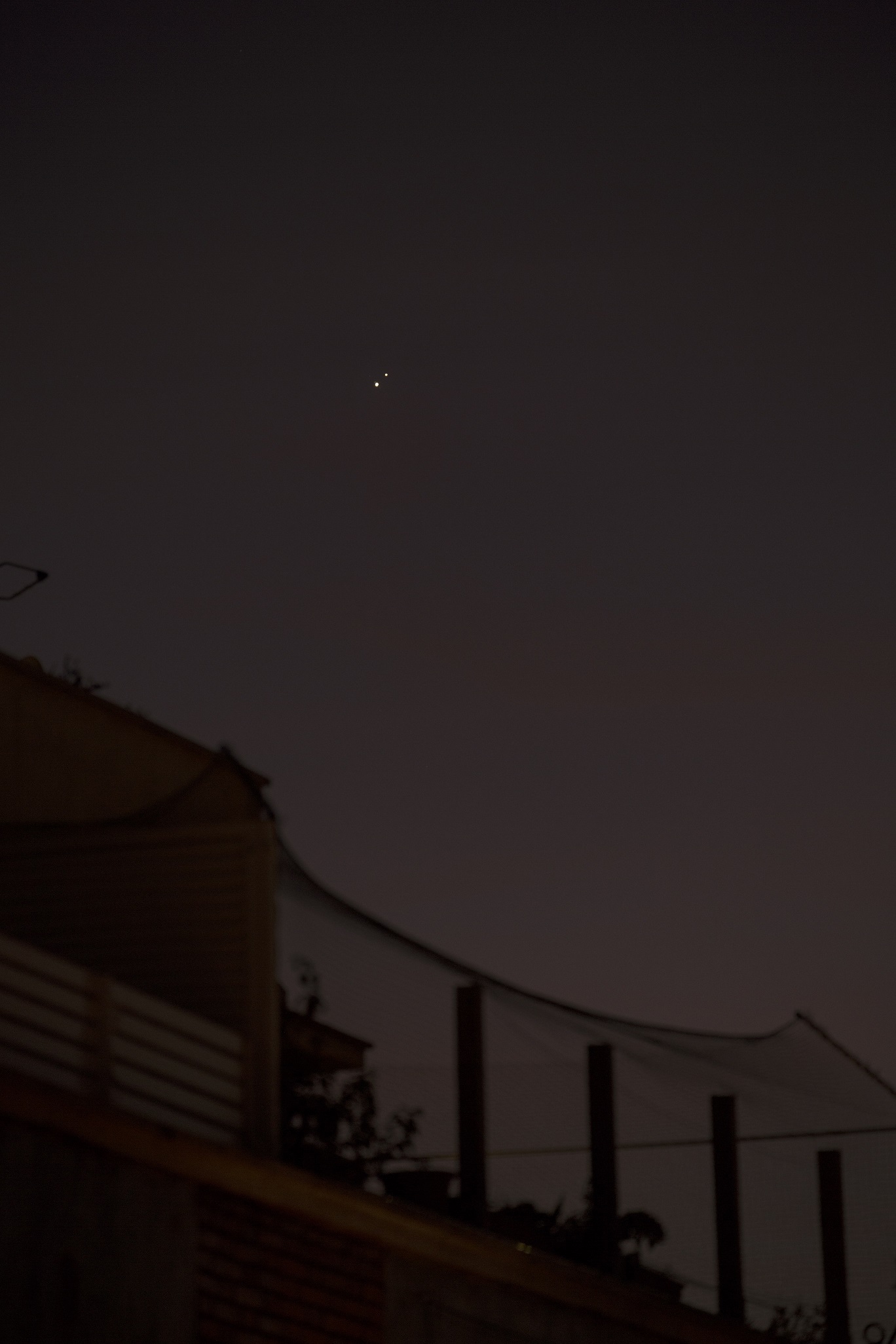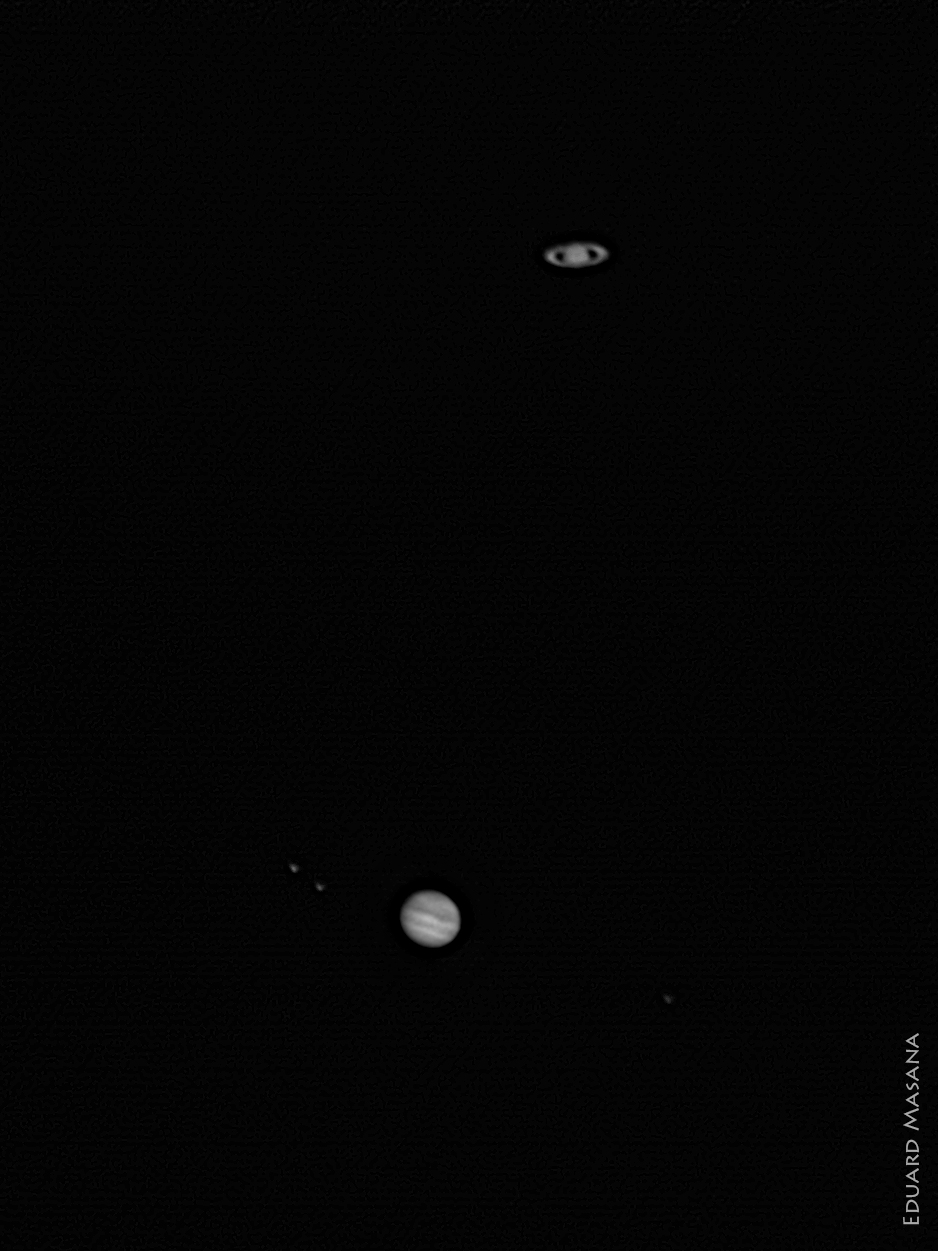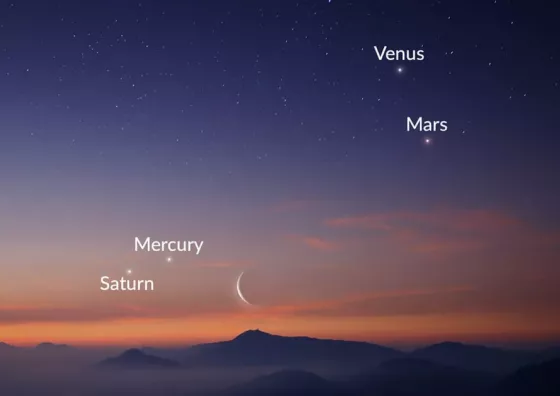What is a planetary conjunction?
The planets in our solar system orbit the Sun in slightly elliptical orbits, including Earth. From our point of view, the planets trace "erratic" movements in the sky against the background of stars, which is why ancient astronomers called them "wandering stars". When the positions of two planets match our line of sight, these planets appear very close in the sky. That's when we talk about a planetary conjunction.
The most common conjunctions include inner planets (Mercury and Venus), because these have short orbits, move quickly in the sky, and therefore the probability of a coincidence of lines of sight with other planets is high. When dealing exclusively with outer planets (Mars, Jupiter, Saturn, Uranus, Neptune), conjunctions between them become infrequent. For example, between Jupiter and Saturn they occur approximately every 20 years. This number comes from taking into account the periods of revolution around the Sun of both planets: 11.8 years for Jupiter and 29.5 for Saturn.
Planetary conjunctions of 2022
This 2022 we will have several planetary conjunctions:
| DATES | PLANETS | SEPARATION |
|---|---|---|
| April 4th | Mars-Saturn | 0.3º |
| April 30th | Venus-Jupiter | 0.2º |
| May 29th | Mars-Jupiter | 0.6º |
*For a reference, bear in mind that the full Moon ocuppies 0.5º in the sky
How to observe conjunctions
Because of their brightness, the planets are easily visible to the naked eye. The brightest planet of the conjunctions will be Venus (magnitude -4), followed by Jupiter (magnitude -2) and finally Saturn (magnitude +0.6) and Mars (magnitude +0.7).
Mars and Saturn, April 4, 2022
We will have to wait for morning, until 05:36h which is the time when both planets rise from the horizon. You will have to look in the east direction. We can't get too distracted because at 07:01, just an hour later, civil twilight will begin and the planets will be barely visible due to sunlight. It will therefore be necessary to have a horizon free of obstacles in the east or south-east direction to be able to enjoy the conjunction until sunrise.
If we have a telescope, both planets will be visible simultaneously in the field of the eyepiece, if we do not work with too many magnifications.
Some data pieces
The following data are calculated for Barcelona. If you want them for any other location, use the website https://serviastro.ub.edu/el-cel-del-dia
|
TIME |
|
HEIGHT |
|
|
05:36 |
Mars and Saturn rise above the horizon |
0 |
Mars and Saturn still invisible to the naked eye |
|
05:54 |
Beginning of astronomical twilight (Sun 18 degrees below the horizon) |
3 |
Mars and Saturn visible, very low above the horizon |
|
06:28 |
Beginning of nautical twilight (Sun 12 degrees below the horizon) |
9 |
Mars and Saturn clearly visible |
|
07:01 |
Beginning of civil twilight (Sun 6 degrees below the horizon) |
14 |
|
|
07:31 |
Sunrise |
18 |
Mars and Saturn invisible due to sunlight |
*Height of Mars/Saturn above the horizon in degrees
Venus and Jupiter, April 30, 2022
We will have to wait for morning, until 05:14h which is the time when both planets rise above the horizon. It will be necessary to look in the east direction. Note that civil twilight (when the Sun is 6º below the horizon) begins only one hour after the planets rise above the horizon, and the planets will be visible with considerable difficulty due to sunlight, so the temporary window to see the conjunction will be very short. It will therefore be necessary to have a horizon free of obstacles in the east or south-east direction to be able to enjoy the conjunction until sunrise.
If we have a telescope, both planets will be visible simultaneously in the field of the eyepiece, if we do not work with too many magnifications.
Some data pieces
The following data are calculated for Barcelona. If you want them for any other location, use the website https://serviastro.ub.edu/el-cel-del-dia
|
TIME |
|
HEIGHT |
|
|
05:02 |
Beginning of astronomical twilight (Sun 18 degrees below the horizon) |
-2 |
Jupiter and Venus still invisible below the horizon |
|
05:14 |
Jupiter and Venus rise above the horizon |
0 |
Jupiter and Venus still invisible to the naked eye |
|
05:42 |
Beginning of nautical twilight (Sun 12 degrees below the horizon) |
5 |
Jupiter and Venus visible but a little low on the horizon |
|
06:19 |
Beginning of civil twilight (Sun 6 degrees below the horizon) |
11 |
Jupiter and Venus visible with difficulty in twilight light |
|
06:50 |
Sunrise |
17 |
Jupiter and Venus invisible due to sunlight |
*Height of Jupiter/Venus above the horizon in degrees
Mars and Jupiter, May 29, 2022
To be able to observe this conjunction, we will also have to wait for the morning, until 03:35h which is the time when both planets leave the horizon. It will be necessary to look in the east direction. In this case, we will have more time to photograph the planets, since the civil twilight (when the Sun is 6º below the horizon) does not begin before more than two hours later, at 05:49 when the planets will be visible with considerable difficulty due to sunlight. It will therefore be necessary to have an obstacle-free horizon in the east or southeast direction to be able to enjoy the conjunction until sunrise.
If we have a telescope, both planets will be visible simultaneously in the field of the eyepiece, if we do not work with too many magnifications.
Some data piece
The following data are calculated for Barcelona. If you want them for any other location, use the website https://serviastro.ub.edu/el-cel-del-dia
|
TIME |
|
HEIGHT |
|
|
03:35 |
Jupiter and Mars rise above the horizon |
0 |
Jupiter and Mars still invisible to the naked eye |
|
04:19 |
Beginning of astronomical twilight (Sun 18 degrees below the horizon) |
8 |
Jupiter and Mars perfectly visible |
|
05:07 |
Beginning of nautical twilight (Sun 12 degrees below the horizon) |
17 |
Jupiter and Mars perfectly visible |
|
05:49 |
Beginning of civil twilight (Sun 6 degrees below the horizon) |
24 |
Jupiter and Mars visible with difficulty in twilight light |
|
06:23 |
Sunrise |
30 |
Jupiter and Mars invisible due to sunlight |
*Height of Jupiter/Mars above the horizon in degrees
Images of past conjunctions from Barcelona

Conjunction of Jupiter and Saturn, December 21, 2020
Credit: Eduard Masana

Conjunction of Jupiter and Saturn, December 21, 2020
Credit: Eduard Masana
About the author
Eduard Masana is an astronomer and researcher of the Gaia group at the Institute of Cosmos Sciences of the University of Barcelona and a member of the Institute of Space Studies of Catalonia. In recent years, he has developed the Gaia GASS simulator and his research is focused on determining stellar physical parameters from photometric data. Masana also participates in several outreach activities, giving talks to the general públic and organizing astronomical observations. He is the creator of the Eclipse 2.0 application for calculating eclipses and planetary transits. His outreach activity places a particular emphasis on Gaia, with the aim of making the mission known to the general public, students or astronomy fans. He is also a member of the editorial board of the Gaiaverse outreach portal.
